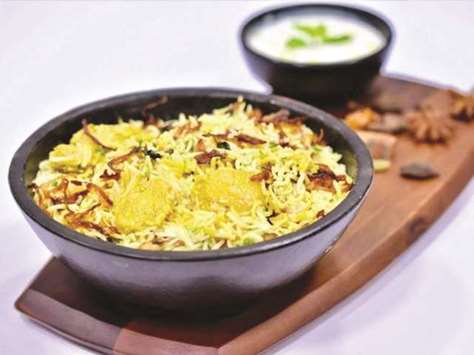Who does not want to enjoy a restaurant style professionally cooked food at the comfort of their home. Everyone has a preference of fancy and exotic restaurant style food. The way food is prepared, garnished and served in a professional kitchen has its own special charm. People always compare food cooked by them at home with the one cooked professionally. I am always asked on how the professionally cooked food tastes so much better. My answer is about the salt content of the restaurant style cooked food, restaurants always keep the salt content quite higher and enrich the food with other seasoning and flavourings to make it taste better.
One common food that is often compared is the biryani and Ramadan is the right occasion to discuss an exotic yet simple biryani recipe with readers. We all enjoy a perfectly cooked biryani with the right amount of seasoning with tender and juicy cooked meat with aromatic long grain rice.
As we have discussed earlier the origin of the dish is up for debate, but most historians agree that this dish emerged in Persia, probably as an infused mix of rice and meat, and travelled to the Indian sub-continent through trade, pilgrimage, and conquest. In South Asia biryani became an instant hit. Many regional varieties are popular with subtle differences and variations. There have always been an ongoing debate on the versions and recipes for these biryanis. Every biryani has four integral parts- Rice, Meat/Vegetable, Marinade and Herbs/Seasoning.
Rice - The most commonly preferred rice used to make biryani is basmati rice, which has its own unique nutty and rich aroma and is long grained and turns milky white after cooked. There are many different sub varieties which are also aged to enhance the quality of the the rice. My father always stock more basmati rice as required to age it and enhance its quality. Some regional varieties of biryani use a number of native grains, mainly from south India.
Meat/vegetable – Chicken, mutton, goat, fish, shrimps, and beef are all used in biryani, based on regional preferences and availability. India being a predominantly vegetarian nation also boasts a variety of vegetable biryanis too.
Marinade - Spiced yoghurt based marinades are the most common. Yoghurt tenderises meats and also give a tart taste to the biryani. Yoghurt also gives body to the marinade and combines all the spices and flavourings and blends it to a paste.
Spices and marinades - Biryani is a dish which heavily relies on the spices and aromatic ingredients used to enhance it. Biryani’s richness and complexity comes in part from its layer of spices. Both ground and whole spices as well as spice mixes, such as garham masala are used in the cooking of biryani. The biryani is garnished with dry fruits and nuts, caramelised onions and more fresh herbs.
Biryani based on cooking process
Mainly, there are three different types of biryani cooking process- dum cooking, kacchi biryani, pukki biryani.
Dum cooked – It is a patient worthy slow cooking method in which the parboiled rice and raw marinated meat are layered in a heavy bottom vessel and the lid is sealed and secured with dough and is cooked over very slow flame for long time.
Kacchi biryani - A method in which raw marinated meat is layered with raw rice and cooked together, dum style.
Pukki biryani - A popular biryani cooking method in which meat and rice are par-cooked separately and assembled and steamed together.
Chicken Biryani Recipe
Ingredients
For rice
Basmati rice 1 ½ cup
Butter 2 tbsp
Oil 1 tbsp
Bay leaf few leaves
Salt 2 tbsp
Cardamom green 4-5 pods
Cloves 3-4 cloves
Cinnamon stick 1-2 stick
Milk ½ cup
For Chicken marinade
Chicken (bone in/ boneless) 500 gm
Ginger garlic paste 2 tbsp
Oil 2 tbsp
Green chili, chopped 1 tbsp
Onion, sliced 1 cup
Tomato, chopped ½ cup
Yoghurt ½ cup
Turmeric, powder 1 tsp
Coriander powder 2 tsp
Red chili powder 1 tsp
Kasoori methi 1 tbsp
For assembly
Saffron strands few strands
Cardamom powder ½ tsp
Cilantro, chopped 2 tbsp
Mint leaves, chopped 2 tbsp
Fried onion 2 tbsp
Garam masala 1 tsp
Rose water 1 tbsp
Method
Wash and soak the basmati rice for 30 minutes
Heat 4 cups of water in a wide base container with salt, milk and seasonings
Add drained rice to the boiling water and bring to boil , reduce the flame and simmer over slow flame
Cover with lid and turn off the flame when the moisture evaporates
Before you start cooking the rice, wash and pat dry the chicken pieces and marinate with yoghurt, ginger garlic paste, salt, red chilli powder, turmeric powder, coriander powder
Refrigerate the chicken for 30 minutes, preferably prepare this a night before for better taste
Heat oil in a skillet and add the sliced onion and sauté till light brown
Add tomato and sauté till tomato softens, add the marinated chicken to the skillet
Cover and cook till the chicken is cooked, adjust the seasoning
In a separate heavy bottom pan add a layer of rice, sprinkle with kasoori methi, saffron dissolved in water and chopped cilantro and mint
Layer the prepared chicken and place a layer of rice and add the remaining saffron water and cilantro leaves and mint leaves, drizzle rose water
Cover with an air tight lid and place the vessel in an oven at 200 degree Fahrenheit for 15 minutes
Serve hot garnished with fried sliced onions and garam masala and raita on side.
* Chef Tarun Kapoor, Culinary Mastermind, USA. He may be contacted at [email protected]

TASTY: Chicken biryani is served hot, garnished with fried sliced onions and with raita. Photo by the author
